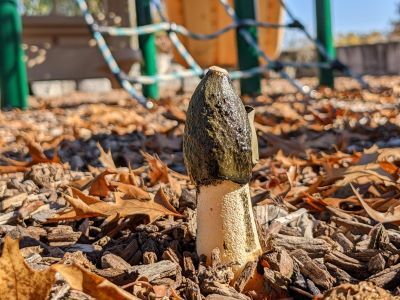
Good Natured: Stinkhorn Mushrooms
So here's a question for you… When you think about the nature in your neighborhood, and the parts of it that symbolize might and power, what images come to mind?
Maybe you're envisioning a magnificent bald eagle, soaring majestically overhead; or perhaps a formidable great horned owl, whose nickname is Tiger of the Sky. Within the plant kingdom you might be picturing a mighty oak or hickory, either of which can stand rock solid for hundreds of years.
I have to admit, if I was asked that question a couple of weeks ago, I probably would have said a cougar a.k.a. mountain lion. They're mighty and powerful—and topical, given that not one but two recently made their way into our state from points west.
But then I had a run-in with a stinkhorn.
You might be familiar with this relatively common family of fungi called Phallaceae. They tend to pop up in wood chips or other areas with an abundance of decomposing wood—a popular substrate for many types of mushrooms. But while other fungi go about their business of breaking down organic matter in quiet fashion, stinkhorns, well…they raise a stink.
We recently became aware of a fine array of a very special stinkhorn, Phallus ravenelii, growing amid the wood chips of one of our St. Charles Park District playgrounds. We'd received a call from a resident who was concerned about the mushrooms, and the smells they were emitting, by the slides and other areas of the play structure.
Mushrooms, you probably know, can make people a little nervous. Although they are important components of our local ecosystems, their role as decomposers often gets overshadowed by their reputation for being deadly. It's true, some are killers—the Amanita genus has species with common names like destroying angel and death cap—but the thing is, they have to be ingested in order to be lethal.
Stinkhorns, by contrast, are not deadly, even if one should, through whatever odd turn of events, end up in someone's mouth.
They do smell bad, at least to some people. Those so gifted describe the odor as pungent and/or putrid and “reminiscent of rotting flesh." Dimethyl trisulfide—the same compound present in overcooked broccoli and stinky cheese—combines with other chemicals to produce the stench, which in turn attracts the flies that help disseminate the mushroom's spores.
But I gotta tell ya, try as I might, I just haven't been able to sense it. I spent a good deal of time crawling around the stinkhorn playground, on two separate occasions, and all I could detect was the smell of…mushrooms.
But what I was able to perceive, and why this mushroom has me so awestruck, is the way it's able to pop up, quite literally, in just a few hours.
As is the case with most fungi, the part we see above ground—the mushroom—is merely the fruiting body of the organism. The workhorse parts, which actually perform the decomposition of the substrate, are a vast underground network of threadlike structures called mycelia.
Pam Otto is the outreach ambassador for the St. Charles Park District. She can be reached at potto@stcparks.org.

